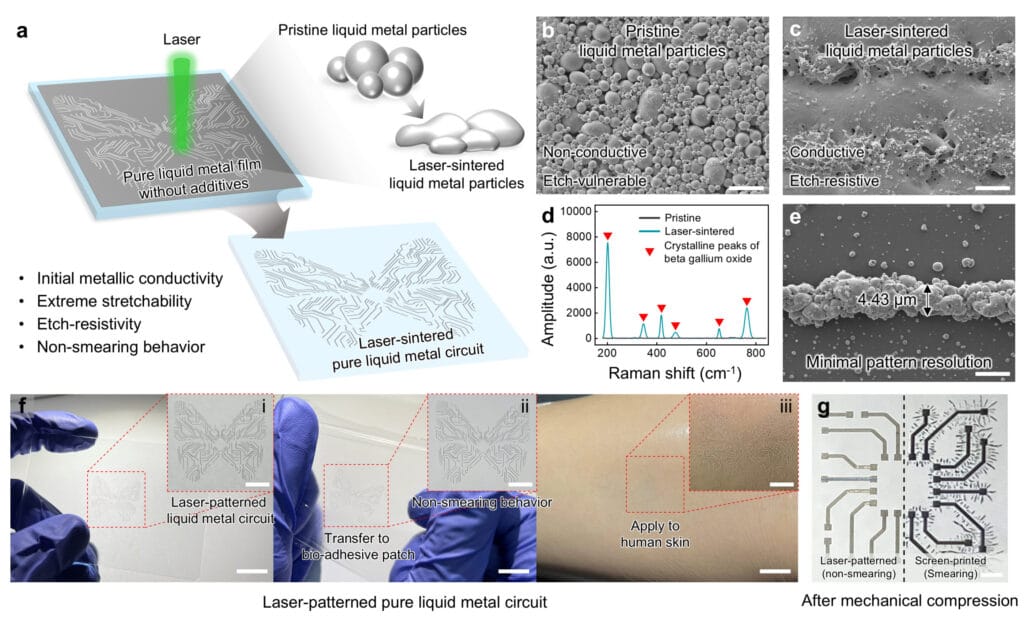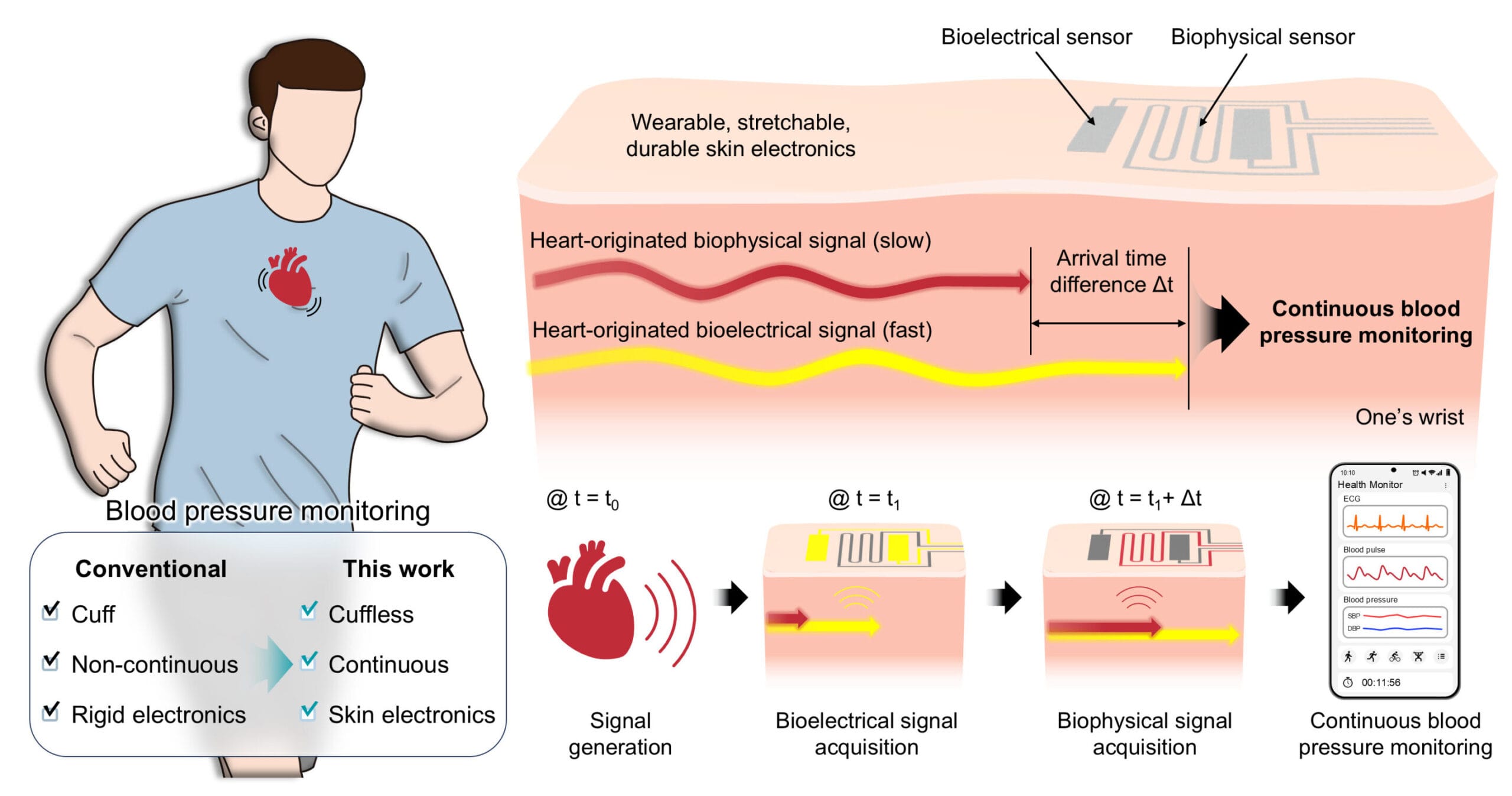Imagine checking your blood pressure as easily as glancing at your smartwatch — no bulky cuff squeezing your arm, no one-time readings at a clinic, no interruptions to your day. That vision is now a step closer to reality thanks to a breakthrough from Seoul National University’s College of Engineering.
A research team led by Professor Seung Hwan Ko of the Wearable Soft Electronics Lab has developed a flexible, skin-like electronic device that attaches to the wrist like a transparent bandage. Once in place, it can monitor your blood pressure in real time, continuously, and comfortably — even while you sleep, exercise, or go about your normal activities.
This work, conducted in collaboration with Carnegie Mellon University, was recently published in Advanced Functional Materials. The device’s potential to transform global health care has already sparked worldwide attention.
Tackling a Silent Killer
High blood pressure — often dubbed the “silent killer” — affects an estimated 1.3 billion people globally. Yet only about 21% of those patients keep their condition under control. Traditional cuff-based blood pressure monitors, the kind that inflate around the arm, remain the standard, but they’re far from perfect. They give only occasional snapshots of blood pressure, require proper positioning, and can be uncomfortable, especially for long-term monitoring.
Because of these limitations, many dangerous blood pressure fluctuations go undetected. Spikes and drops that occur during daily activities, exercise, stress, or sleep can hint at serious cardiovascular risks — but the current tools often miss them. The need for a comfortable, reliable, and truly continuous monitoring solution has never been more urgent.
The Science Behind the Patch
Instead of squeezing an artery to estimate pressure, the new device reads your body’s own internal signals. The method hinges on a subtle time difference between two events that happen every time your heart beats:
- Electrical signals — detected via an electrocardiogram (ECG) — spread instantly throughout the body.
- Mechanical signals — tiny pulses of blood flow that cause the skin to move — take slightly longer to reach the wrist.
When blood pressure is high, the blood moves faster, narrowing the gap between the two signals. When it’s low, the gap widens. By precisely measuring this difference, the device can calculate both systolic and diastolic blood pressure in real time, beat by beat.
But detecting these microscopic skin movements isn’t easy. That’s where materials science comes into play.
Liquid Metal, Laser Precision
To sense such delicate changes, the team turned to a remarkable material: liquid metal. Unlike solid conductors, liquid metal remains soft and elastic at room temperature — stretching and flexing just like human skin — while still conducting electricity extremely well.

There was a problem, though. Liquid metal has very high surface tension, making it hard to mold into precise, stable circuits. To overcome this, the team invented a process called laser sintering. By firing a laser at dispersed liquid metal particles, they could fuse them together only where needed, drawing fine, stable circuits directly onto a flexible substrate. The result: a sensor that’s both highly conductive and stretchable without breaking.
This device can stretch to seven times its original length and survive over 10,000 stretch cycles without losing accuracy — essential for something designed to move with the human body.
More Accurate Than the Cuff
When the researchers tested the device, it not only matched the performance of traditional cuffs — it often exceeded them. In exercise trials, the patch captured rapid blood pressure changes before, during, and after workouts with greater precision than standard equipment. This means it could detect patterns that cuff-based monitors might miss entirely.
And because it’s unobtrusive, patients could wear it for hours, days, or even longer, allowing for a far richer, more detailed picture of cardiovascular health.
Beyond Hypertension
While the patch is a game-changer for people with high blood pressure, its potential uses extend much further. Continuous blood pressure monitoring could help optimize athletic training, track recovery after surgery, and provide early warning of cardiovascular events in high-risk workers. Combined with wireless communication and AI-driven analytics — both planned in future versions — it could become a cornerstone of the coming smart health care era.
“Traditionally, we’ve accepted the idea that blood pressure is something you measure once a day, at best,” says Professor Ko. “But your body is dynamic. Real-time, noninvasive monitoring opens new doors for preventive medicine, lifestyle coaching, and emergency detection.”
Looking Ahead
Co–first authors Jung Jae Park and Sangwoo Hong are now working on integrating the patch with other biosignal sensors and making it compatible with wearable electronics like smartwatches and clothing-based health trackers. They’re also exploring ways to pair it with AI systems that could analyze long-term patterns and recommend lifestyle adjustments before problems escalate.
In the not-so-distant future, checking your blood pressure might be as effortless — and as constant — as breathing. With innovations like this, the invisible threat of hypertension could finally meet a visible, wearable solution.
More information: Jung Jae Park et al, Highly Sensitive Cuffless Blood Pressure Monitoring with Selective Laser‐Sintered Liquid Metal Conductors, Advanced Functional Materials (2025). DOI: 10.1002/adfm.202505089





